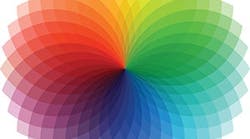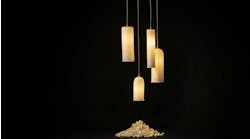We spend our lives inside buildings, our emotional well-being shaped by their structure and interior. This is especially the case within the healthcare environment, where the building and its décor can play a huge role in the healing process.
Part of this involves bringing nature indoors—utilizing space, lighting, aesthetics, and the outside world to appeal to our natural affinity with nature, also known as biophilia. Through this process, architects and designers are reuniting humans with an environment that they are more comfortable in. Indeed, in one study 95 percent of all individuals who were asked how to alleviate a stressful situation responded that being outdoors was the most useful strategy. This explains the extensive evidence showing that patients who have access to nature heal more rapidly.
But creating a truly empathetic healthcare environment involves more than adding windows or healing gardens. Designers must use the full palette of sensory tools available to them, including color, lighting, and music, to create spaces that fully support patients’ well-being.
color and response
Colors generate an emotional response, which is why greater value is being placed on chromotherapy, or color therapy, in healthcare environments.
Rooms and halls in warm earthy tones or soft ocean tones have been found to lower stress levels in patients while also evoking a positive mood. Professor Max Lüscher, head of the Institute of Psycho-Medical Diagnostics in Switzerland, believes the common association of tranquillity with the color green may be the result of early humans’ use of green forests or jungles as an escape from the open fields of sunlight.
White hospital walls and corridors are a thing of the past and tend to be associated with sterility. Furthermore, based on research, the use of monochromatic color schemes can appear institutional, and should therefore be avoided. Healthcare facilities now tend to borrow colors from nature, as well as those used traditionally in spas, hospitality, and retail to either soothe or energize.
Researchers have found that while there is no evidence for any one color impacting healthcare outcomes, an understanding of the elements of color when designing healthcare facilities can impact healing. Sara Marberry, a healthcare design knowledge expert with Midwestern University, says, “Color is literally the ‘wavelength’ medicine of the future. It calls to us and asks us to recognize its value as an alternative medicine that the environment can provide.”
Seeing a color is not an isolated event within the body. When it is interpreted by the brain, a physiological response is triggered which activates the cortical center of the brain—the part associated with memory, attention, and perception. It also activates the autonomic nervous system—our control center—which functions primarily below our consciousness and regulates heart rate and blood pressure.
The Colors of Healing
According to Celeste Allen Novak Architect PLLC, which specializes in holistic sustainable design and planning in Ann Arbor, Mich., the health effects of colors can be broken down accordingly:To use red as an example, when the color is viewed, a corresponding stimulation of the adrenal gland occurs. The adrenal gland, which sits at the top of the kidneys, is responsible for releasing hormones in response to stress; therefore, seeing red causes an increase in heart rate and blood pressure, which is needed for alertness and vitality. Yellow has a physiological effect on the thyroid gland, the part of our anatomy that controls how quickly the body uses energy, stimulating the brain and nerves and making the muscles feel more energetic.
light and rhythm
Related to color, which is translated from light reflecting on the eye, is the use of phototherapy, or the harnessing of light to treat medical conditions. Light is made up of different spectral distributions and wavelengths. Natural light, and to a lesser degree, full-spectrum fluorescent lighting, is made up of every wavelength or color in the spectrum. (Incandescent lamps, cool white fluorescent lighting, and energy-efficient fluorescent lighting lack the blue portion of the color spectrum, which is most important for optimal brain and body function.)
Natural lighting increases serotonin levels and helps regulate circadian rhythms. Serotonin is a neurotransmitter chiefly linked to positive feelings and happiness, while circadian rhythms help regulate our sleep, both of which are fundamental to emotional well-being. An additional physiological effect of full-spectrum or natural light is a reduced response to stress hormones such as the adrenocorticotropic hormone (ACTH). These hormones are responsible for our fight-or-flight response in dangerous situations, but in normal (albeit stressful) conditions, they can actually be harmful.
Alzheimer’s patients exposed to full-spectrum lighting and darkness during sleep report a decrease in agitation and insomnia. Furthermore, our bodies take Vitamin D from sunlight, which stimulates the absorption of calcium and increases bone density. These are important nutrients for general health, but even more vital when recuperating from an illness.
music and mood
Given the evidence supporting the link between nature and healing, psychoacoustic therapy, or music therapy, combined with the sounds of nature has become popular. The sounds of wildlife, rain, birds, and waves, for example, are being integrated with soft classical music to lower anxiety and increase comfort within healthcare settings.
Music therapy, utilizing all but the loudest and most jarring forms, has been used to manage chronic and postoperative pain. Personal music preferences play a role in its efficacy for pain management, since the more appealing the music is to the individual, the more they focus on it. Physiologically, pleasant music causes the release of endorphins, which reduces pain, and also lowers heart rate and blood pressure by slowing down breathing.
Music that is favored by an individual will similarly cause the brain to release dopamine, the “feel-good” hormone that is essential for preventing depression and increasing a ‘high’ feeling. The type of music is not important for healing; opera, rap, metal, or any other genre will have the same effect as long as it is the preference of the patient. By decreasing levels of cortisol, music also improves immune function.
In short, evidence-based design that attends to the emotional well-being of people is the future of healthcare architecture. Indeed, architectural psychology is helping create buildings from the occupants’ point-of-view, leading to structural empathy in modern buildings. The practice of green and biophilic design, in particular, brings people closer to the healing powers of nature’s sights and sounds. What the interior design community can learn from this is to make healthcare more about hospitality than hospitalization.
Dr. Nicola Davies is a psychologist, researcher, and freelance writer with an interest in architectural psychology and person-centred care. Follow her at @healthpsychuk.


